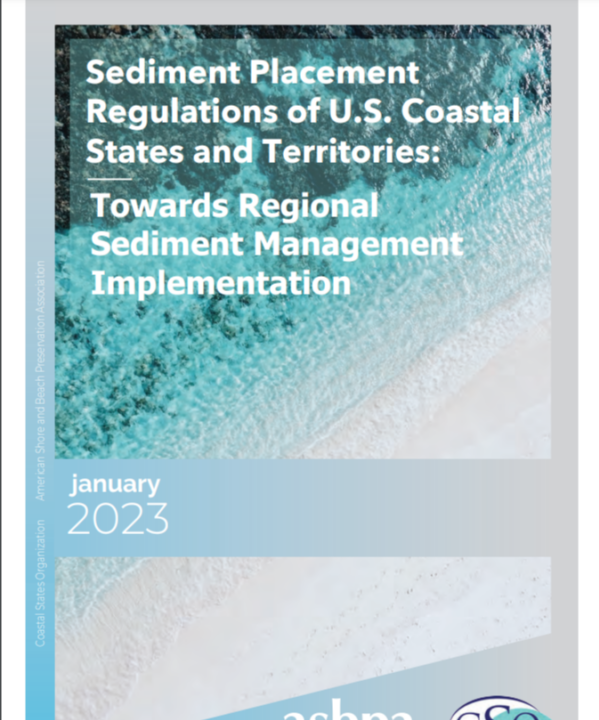Abstract or Summary

The American Shore & Beach Preservation Association (ASBPA) and Coastal States Organization (CSO) partnered with the U.S. Army Corps of Engineers’ (USACE) Institute for Water Resources (IWR) to support state and federal Regional Sediment Management (RSM) priorities by developing a comparative analysis of relevant federal and state/territory policies and regulations. The goal of this project was to highlight best practices and coastal program successes in managing sediment resources and elevate effective RSM and beneficial use of dredged material (BUDM) policies and regulations in the national spotlight.
Engagement of state and federal policy makers, regulators, and project managers was a high priority during this project. In addition to a desktop review of policies and regulations and interviews with coastal regulators, the project involved seven regional workshops that included a total of nearly 250 participants, 28 presentations, and 25 breakout sessions.
Sediment placement regulations, and related state and federal policies, are frequently cited as a significant limitation to implementing RSM. Meanwhile, confined disposal areas for the placement of dredged coastal sediment are at or near maximum capacity. At the same time, the demand for finite sediment resources is increasing to respond to climate change and restore eroding shorelines. Congress has responded to the need for improved sediment management with several important authorizations, including the Water Resources Development Act (WRDA) of 2020, Section 125, which establishes a national policy to maximize the beneficial use of sediment obtained from USACE projects. USACE has also recently set a goal to increase BUDM to 70% by 2030 (Coleman 2022).
Coastal stakeholders have expressed a strong desire to collaborate with federal agencies and devote additional resources to coordinate short- and long-term sediment management. With only three exceptions (Alaska, the U.S. Virgin Islands (USVI), and the Commonwealth of the Northern Mariana Islands [CNMI]), all U.S. coastal states and territories have adopted policies to encourage, or even require, that suitable dredged sediments are used in a beneficial manner. All U.S. coastal states regulate the percent of fine-grained sediment (“fines”) in general shoreline placement projects through either qualitative (similar to native) or quantitative (measurable) policies.
The state- and federal-level recommendations of this report emphasize collaborative efforts. While the most appropriate tools for a jurisdiction will depend on the state’s or territory’s statutory authorities, capacities, priorities and needs on the ground, the following recommendations summarize options for coastal states and territories.
● Policy and regulatory: Incentivize BUDM through funding, regulatory, and planning requirements, testing 4 U.S. Sediment Placement Regulations waivers, streamlined permitting, and clear technical guidance.
● Interagency collaboration: Proactively and frequently host participatory planning and implementation discussions among BUDM champions at a regional scale to discuss pilot projects and permitting efficiency and develop collaborative guidance and plans.
● Funding: Collaboratively develop flexible BUDM policies and programs that identify cost-saving opportunities, funding sources, and partners.
● Project development and review: Implement effective and efficient project development and review procedures through collaborative consultations and improved technical guidance.
Federal-level recommendations propose key actions and priorities that federal partners can pursue to strengthen BUDM policies around the nation as follows.
● Policy and regulatory: Support the USACE goal of increased BUDM, including through developing implementation guidance and procedures to better assess economic and environmental benefits and improve stakeholder engagement.
● Interagency collaboration: Sustain and increase interagency collaboration to streamline permitting, manage environmental trade-offs, and renew a national commitment to sediment management.
● Funding: Increase opportunities to fund BUDM projects through collaborative valuation and policy determinations and expanded funding mechanisms.
● Project development and review: Collaboratively develop and implement 5-Year Regional Dredged Material Management Plans (RDMMP), increase staff capacity, and explore BUDM opportunities under existing authorities.
Research investment is needed to develop cost-effective, accurate, and efficient methods to determine sediment suitability, and to improve the understanding of changes in physical sediment characteristics during the dredging process to inform a regulatory shift toward science-based requirements.